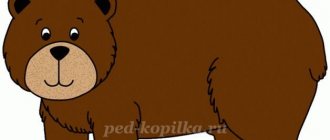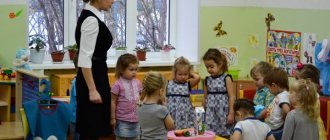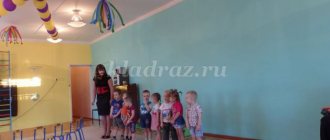Lesson summary - entertainment in mathematics in the second junior group
Lesson summary - entertainment in mathematics on the topic: “Journey to the Fairytale Forest.” Junior group
Developed and conducted by the teacher of the MB preschool kindergarten No. 199 Sipratova Klavdiya Viktorovna, Ulyanovsk.
Description of the material: I offer you a summary of a fun lesson in mathematics for children of the second junior group (3-4 years old) on the topic: “Journey to a fairy-tale forest.” This material will be useful to teachers of the second younger group, as well as parents who have children 3-4 years old. This material is presented in a playful form and is aimed at generalizing and consolidating knowledge about geometric shapes, the ability to compare objects by length and width, and establish equalities and inequalities between two groups of objects. Integration of educational areas: “Cognition”, “Communication”, “Socialization”, “Artistic and Aesthetic”. Program content: 1) train children in the ability to distinguish geometric shapes: circle, square, triangle. Reinforce the concepts of “one”, “many”; 2) consolidate children’s ability to compare objects in length and width, denoting the result with the words “longer-shorter”, “wider-narrower”, “equal in width”, “equal in length”; 3) consolidate the ability to establish equalities and inequalities between two groups of objects located in a row, to use the expressions “more”, “less”, “equally”; 4) cultivate in children the ability to listen to the teacher, to act on the teacher’s signal; friendships between peers. Previous work: children practiced distinguishing shapes; played the game “Find the same one”; learned to compare objects by length and width, denoting the result in words; practiced the ability to establish equalities and inequalities between two groups of objects. Equipment: demonstration material: tambourine, three hoops, circle, square and triangle;
two large toys - a bear and a bunny; two strips of the same length, but different widths. handout: for each child, geometric shapes - circles, squares, triangles; strips - 2 for each child of the same length, but different widths; a flower cut out of paper (for each child). Progress:
I seat the children at the tables and say: “Guys, today we will go on a journey through the Fairytale Forest.
And we will go to the forest by train (I show the children the train, which is built from chairs). Take all your seats, sit down comfortably. We went with you to the Fairytale Forest (the song “Train” by music by Metlov is playing). Guys, here we are and we have arrived in the Fairytale Forest. The clearing we are in is called “Find Your House”. Now I will distribute geometric figures to you all, and you tell me what geometric figures I gave to you (I ask 6-7 children). Well done, these are circles, squares and triangles - these are geometric shapes. All these figures live in houses, here they are (pointing to the hoops lying on the floor). Now you will all run around the clearing, and when I hit the tambourine, each of you will have to find your own house. Whoever has a circle runs to the house where the circles live, who has the squares - to the house where the squares live, and who has the triangles - to the house where the triangles live (after which the game begins, when the children have found their house, I clarify: “Guys , (pointing to the children who are standing in the house where the circles live), what kind of figure do you have? (that’s right, a circle). Sasha, how many circles do you have? (one) (I ask 2-3 children). That’s right, you have each one circle. And how many circles are there in a hoop? That's right, a lot. (I ask 2-3 children). (The game is repeated several times; when repeated, you can swap the hoops or the figures lying inside.) Well done, kids, they were able to find their house and don't make a mistake. Now get on the train, we'll go with you to another clearing (the song "Train" by Metlov's music sounds). We've arrived. Look, there's a bear and a bunny sitting there, they're crying. Let's go up to them. Why are you crying, little teddy bear and little bunny? ? Guys, they say that they can’t find which path is narrow and which is wide. If they follow the narrow path, they will wander into the Dense Forest, and if along the wide path, then to the Fun Squirrel. Help them find where the path is narrow and where the path is wide (I hand out strips to the children). Guys, first show me the length of each track (they show), and now the width (they show). Guys, what are the length of the tracks? (I ask 3-4 children). That's right, they are equal in length. How wide are the tracks? (3-4 answers) (narrow and wide). How do you know which path is narrower and which is wider? What do I need to do? That's right, put the strips on top of each other. Put them on (children compare the stripes and determine what they are). Okay, well done! Guys, tell us how you compared and what happened? (2-3 answers). So which strip is wide and which is narrow? (2-3 answers). Right. The white stripe is wide, and the green stripe is narrow. If a bunny and a bear walk along the green path, where will they wander? (to the Deep Forest). And if - along the white carpet? (to the cheerful squirrel). So, bear and bunny, walk along the wide white path and it will lead you to the cheerful squirrel. Well, the guys and I will go to another clearing. Guys, get on the train and let’s go (the song “Train” by Metlov is playing). Guys, we have arrived at the clearing. Take a rest. Physical education minute. Now music will play here, and you will dance (I turn on the music - the children dance). Guys, look how many flowers have grown in the clearing! How many are there? (a lot of). Let's play the game "Butterflies and Flowers" with you. You are all turning into butterflies. Sasha is a butterfly, Seva is a butterfly, Katya is a butterfly. How many butterflies do we have? (a lot of). The butterflies have flown! (children wave their “wings” - their arms and run around the clearing. At the signal: “Butterflies!” - the children sit down, i.e. stand near their flower). Guys, look, there is a butterfly on this flower, a butterfly on this flower, and a butterfly on this one too. What are more (less) flowers or butterflies? That's right, they are equal! There are as many flowers as there are butterflies, and there are as many butterflies as there are flowers. The butterflies rested and flew again (the game is repeated 2-3 times). Well done boys! Today we had a good trip through the Fairytale Forest. And now it’s time for us to go to the group (the children get on the “train” and, to the music, we go to the group). Here we are. Let's remember where we were today, what we did, who did we help? (I’m summing up the fun activities with the children). Well done boys! Our journey to the Fairytale Forest is over, you can go and play.”
We recommend watching:
GCD on FEMP in the second junior group Summary of organized educational activities on FEMP in the second junior group Synopsis of a frontal lesson on FEMP in the 2nd junior group GCD in mathematics in the 2nd junior group
Similar articles:
Math lesson notes. Theme: “One - many, big - small.” Second junior group
Math lesson notes. Topic: "Circle". Second junior group
Summary of a lesson on FEMP in kindergarten in the second junior group. Topic: “Spatial relations”
Summary of a lesson on FEMP in kindergarten in the second junior group. Triangles
Summary of lessons in kindergarten in the younger group. Topic: “Parts of the day”
Methodology for conducting GCD in mathematics in early preschool age
An important rule that guarantees results is to conduct classes not only in the kindergarten group. At home, the child must also develop and study with his parents.
Important! After home lessons, the child may want to brag about his successes to his family. In this case, the baby should receive a portion of admiration from praise.
When the first math lesson is held in the second junior group, the children are divided into small teams. This division lasts only a month, then they all study together. This is due to the fact that such an exact science is still quite difficult for children.
Senior groups immediately begin general classes, starting in September. The duration of classes depends on the group. In younger groups, lessons last 15 minutes. The time gradually increases to half an hour in older groups. An event that takes too long, even in its lightest form, will tire even the older guys.
The lessons themselves are held before lunch, when concentration is not greatly reduced. To relax, a subject that requires mental stress alternates with active games or physical exercises.
For your information! The FEMP program is carried out from September to May, then knowledge is supported in a game-based didactic form. There are no classes during the summer.
The volume of study is no more than 1 topic per lesson. The child's brain should not be overloaded. For example, in one lesson a child gets acquainted with the shape of a square, in the next with a circle, and only then a triangle is studied. Classes are held on a weekly basis.
Lesson at home with parents
Techniques for forming mathematical representations
To form ideas, special preparation is carried out. The main technique that is used in almost all activities is play. This is important for a preschooler. In addition, the teacher can use additional methods:
- oral-verbal;
- visual;
- practice.
A child at 5 years old - what children should know and be able to do by the age of five
Methods are selected depending on the end goal or task. Also, when selecting, the characteristics of the group of children are taken into account. The chosen methodology also depends on the topic. Some methods are suitable for some topics, and others are suitable for others. It is common to mix methods. Game methods can be subject-oriented, plot-oriented or follow a script.
Important! The best results come from practice and playful learning. To do this, objects and actions with them are used. Visual memory develops.
The form for submitting assignments can be any. If necessary, the teacher can choose an individual form. An exercise to consolidate knowledge is selected based on the topic being studied. In most cases, group work is used, as it saves the teacher’s time, teaches kids cohesion and the ability to work in a team, which is a positive thing.
When using the game method, tasks should develop mathematical thinking and teach the child to master the data obtained in previous games. Games make it easy to explain space and size, colors, sizes.
It is recommended to reserve the visual method for those cases when you need to explain a topic that is easily demonstrated. For example, the lesson is about length and height. Visually, the child will immediately be able to distinguish long or short, tall or short. Concepts such as “left”, “right” and “center” require mandatory demonstration.
Division into groups
Of the oral methods, the most popular are explanations or instructions. The task is given orally. The child learns to listen to the teacher. Auditory memory and imagination develop. At the same time, information must be presented in portions. If too much is said verbally, the baby will not remember and will lose interest in the process.
To consolidate, one of the verbal forms is used - questions. Only by asking the child and listening to his answer, you can conclude whether he understood the topic or not. This method helps develop speech and communication skills. Each time the preschooler will answer faster and more correctly.
Note! A small quick survey is conducted at the end of each lesson. If the child does not understand, you should have a conversation and convey the necessary information to the child.
Progress of the lesson
At the preparatory stage, a lesson outline is drawn up and the necessary materials are prepared. If necessary, dummies are used. A selection of riddles, fairy tales and musical accompaniment is carried out in advance.
It is necessary to choose the form and methodology of conducting the lesson. For important topics, you can use an open lesson that will be attended by a guest. If parents of preschool children are invited as guests, the children will be more active.
A fairy tale or cartoon is chosen as the basis on which the game will be based. The chosen character should be loved by children and motivate them.
Mini blitz survey to consolidate knowledge
The teacher announces the essence and conditions of the game, passing off the character as the initiator of the game. Distributes necessary items or cards and all props. For example, if preschoolers are learning to count, then they are given counting sticks or other objects for counting. Riddles, stories and poems are designed to help make the task easier. Thanks to them, children will better understand the task.
Neurodynamic gymnastics for brain training in children
Important! After the main part, you can do physical exercises accompanied by music. After it, the children will relax and throw out the accumulated tension.
In conclusion, what has been learned is consolidated and the results are summed up. The guys need to say words of praise and emphasize that they are great. You can close the topic with the help of fairy tales, poems, music and songs.


